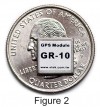GPS Tracking
By Bryan Bergeron
Today, electronics continue to play a central role in maintaining the security of government and business offices, and tracking the movement of persons of interest. While miniature cameras have many uses in electronic surveillance, tracking is increasingly reliant on low-cost GPS receivers. You’ve probably seen or read about the GPS-based ankle bracelets for prisoners on house arrest, collars for dogs, and watches for children and the elderly that enable a guardian to monitor the wearer’s whereabouts. However, these systems are generally closed and require a subscription service to enable the reporting features.
Fortunately for the experimenter, the same technology used in these GPS-based tracking services is available in accessible, affordable packages. Microprocessor-friendly GPS modules are available from Parallax ([url=http://www.parallax.com]http://www.parallax.com[/url]) and SparkFun Electronics ([url=http://www.sparkfun.com]http://www.sparkfun.com[/url]), among others.
The Parallax GPS Receiver Module, shown in Figure 1, is an affordable ($90) way to get your feet wet in GPS tracking, whether for a tracking system, robot navigation, or mapping. If, like me, you’re a Stamp fan, then the module is hard to beat, given its Stamp-ready hardware interface. My main reservation with the Parallax offering is that the source code for the programmable Parallax SX microprocessor associated with the module isn’t supported by Parallax.
SparkFun Electronics is my favorite source for hard-to-find and one-of-a kind miniature components and assemblies. They offer a dozen different GPS modules in the $55-$75 range, including the micro-miniature GPS receiver shown in Figure 2. However, unless you’re really good with a hot air pencil, you’re probably better off with one of their slightly larger modules with built-in antenna and connectors, a complete GPS logger kit, or a finished (but accessible) GPS logger.
The SparkFun GeoChron GPS Logger, shown in Figures 3 and 4, is a ruggedized assembly of their EM408 GPS receiver and antenna ($65), 1 Ah lithium polymer battery, built-in charger circuit, and SD card reader/writer. The GeoChron seems designed to be modified, given the ease with which the unit can be disassembled. It sells for $150, without SD card or DC charger.
Although sturdy, the GeoChron isn’t something you can slip unnoticed into a pocket. It measures 4-1/8 x 2-3/4 x 1 1/8” and weighs just over 5 oz. It is easy to set up and use. Simply insert a blank SD card in the slot at one end of the unit and turn on the power. The unit writes a setup file to the card which you can modify with a text editor to specify what data to record and the update frequency.
The interface is easy to learn and consists of a status LED and two rocker switches. I’d prefer recessed switches to prevent accidentally powering down the unit, but the switches do require a fair amount of force to operate. The logger runs for a little over seven hours if you opt for continuous tracking — and up to several days if you configure the unit to write to the SD card less frequently.
The GeoChron can sleep for 500 hours. I like the SD card feature because it’s a simple matter to eject the card from the unit, pop it into an SD reader, and upload the tracking file to one of several free GPS mapping sites, such as GPS Visualizer ([url=http://www.gpsvisualizer.com]http://www.gpsvisualizer.com[/url]). GPS Visualizer converts the tracking data to a path displayed on a Google Earth map ([url=http://www.earth.google.com]http://www.earth.google.com[/url]).
To test the GeoChron, I tossed the unit into my bike panniers to track my daily commute. When I arrived at work, I uploaded the tracking file to GPS Visualizer. The output, shown in Figure 5, consists of the purple line tracing my trek from Brookline to Cambridge, MA. Applications range from route analysis to determine if a commercial driver took the shortest routes, to monitoring use of the family car.
There are other affordable GPS-based tracking options, including the SPOT Satellite Personal Tracker ([url=http://www.spotgpspersonaltracker.com]http://www.spotgpspersonaltracker.com[/url]), available from REI ([url=http://www.rei.com]http://www.rei.com[/url]) and other recreation retail outlets. With the $150 unit designed for use in remote areas without cell phone coverage, you can pinpoint your location to friends or alert a 911 dispatcher to send in the rescue helicopters. There is a modest annual service fee for the satellite service subscription. SPOT, GPS-enabled sports watches, and other personal trackers are excellent uses of GPS technology. However, unlike the GeoChron or Parallax GPS module, they’re closed systems that don’t lend themselves to experimentation — and that’s what we’re all about. NV





Comments





